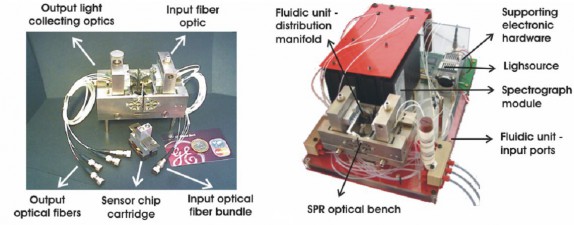Optical biosensor for rapid detection and identification of chemical and biological substances in the field
Year: 2005
Assoc. Prof. Jiří Homola, Ph.D., DSc.; Jakub Dostálek, Ph.D.; Marek Piliarik, Ph.D.; Ivo Tichý, MSc.; Jan Habr, MSc.
Surface plasmon resonance (SPR) biosensors hold potential for many important application areas where sensitive, rapid and label-free detection of chemical and biological substances is required. These areas include medical diagnostics, environmental monitoring, pharmaceutical research, food safety, and security.
We have developed a novel portable SPR sensor for rapid and direct detection of chemical and biological analytes in the field. The SPR sensor is based on a unique patented design combining wavelength modulation and wavelength division multiplexing (WDM) [1] of sensing channels to allow for simultaneous detection of multiple analytes [2]. The core of the sensor system is a miniature optical sensor bench (Figure, left) which is integrated with a source of white light, a spectrograph module, a sample management system, a sensor chip cartridge, a temperature stabilization module and supporting electronic to yield a robust yet compact sensor instrument (Figure, right). In order to make the sensor sensitive to selected chemical or biological analytes, the surface of a sensing channel is functionalized with appropriate biorecognition elements (e.g. antibodies, oligonucleotides).
Možnosti tohoto nového senzoru byly demonstrovány v modelových experimentech, ve kterých byly detekovány látky, které v životním prostředí negativně ovlivňují činnost žláz s vnitřní sekrecí (atrazin, kyselina 2,4,-dichlorofenoxyoctová, benzo[a]pyren a 4-nonylphenol).
- J. Dostálek, H. Vaisocherová, J. Homola: Multichannel surface plasmon resonance biosensor with wavelength division multiplexing, Sensors and Actuators B, 108, 758-764 (2005).
- J. Homola, H. Vaisocherová, J. Dostálek, M. Piliarik: Multi-analyte surface plasmon resonance biosensing, Methods, 37, 26-36 (2005).


